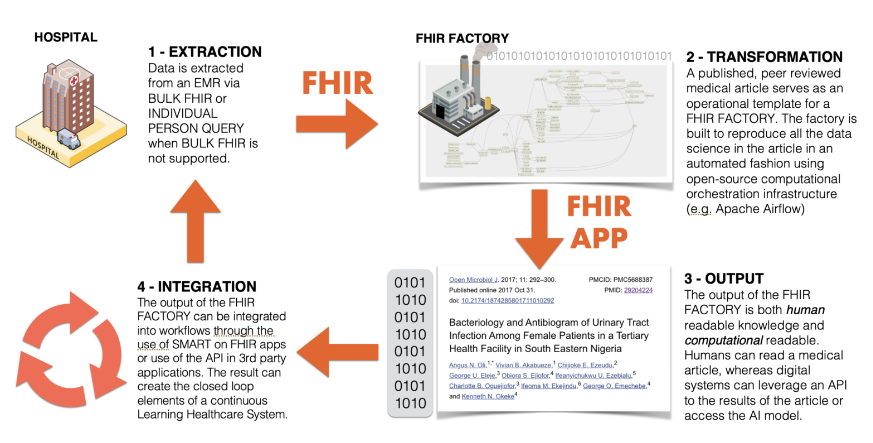 By Alison Kemp, ONC
By Alison Kemp, ONC
X: @ONC_HealthIT
Researchers, developers, and clinicians have new tools to help them access high-quality electronic health record (EHR) data more effectively. A 2020 ONC Leading Edge Acceleration Project (LEAP) in Health IT awardee, MedStar Health Research Institute, in collaboration with the Georgetown University Medical Center and HealthLab, developed two new data tools as part of MedStar’s Fast Healthcare Interoperability Resources® (FHIR) Factories: An Evolving Digital Architecture to Scale Health Research project. The project team developed FHIR Factories, which are enhanced data platforms (or data factories) that provide researchers the ability to easily access data in standardized formats and to conduct at-scale extraction and analysis. These data factories use FHIR to transform data into actionable knowledge that is accessible via application programming interfaces (APIs) and bring that actionable knowledge to the frontlines of clinical care.
The two new data tools available via ONC’s GitHub repository (registration required) include the Bugs & Drugs FHIR Factory and the Trend Engine FHIR Factory, which were specifically designed to leverage standardized Health Level Seven International ® (HL7) FHIR data, as required by the ONC Cures Act Final Rule for certified health IT.
The framework for these FHIR Factories performs automated, iterative extraction of data, transformation, and integration of the data, using the FHIR API. The FHIR Factories’ infrastructure also provides end-to-end, closed-loop automation. These open-source and open-standard tools promote interoperability and the introduction of HL7’s FHIR standard into the data factories and creates a pathway to interoperable data extraction and analysis through the FHIR Factory platform. Thanks to leveraging FHIR, the tools work with any EHR and are not limited to a single vendor.

Figure 1: FHIR Factory overview including four iterative steps: (1) extraction; (2) transformation; (3) output; and (4) integration. In step 1, patient data can be extracted with bulk FHIR, which pulls large quantities of data via the FHIR API, while an individual person query would extract data one person at a time.
Bugs & Drugs FHIR Factory with SMART-on-FHIR app
The Bugs & Drugs FHIR Factory provides near real-time, continuous antibiograms that define drugs of choice for treating urinary tract infections.
Antibiograms are profiles of how susceptible certain microorganisms are to antimicrobial drugs and are used to help identify which antibiotics to give to a patient while waiting for their specific microbiology culture and susceptibility results.
The SMART app created to work with OpenEMR takes an antibiogram created by the FHIR Factory and shows it to the provider; power calculations and statistical significance are included in the results table. The antibiogram will update as new information is added to the EHR, which means it can be more up-to-date than traditional published research. It can also enable the tracking of local and regional antibiotic resistance. Modifying the Apache Airflow based FHIR Factory can enable the tool to be used to create antibiograms for other classes of infections as well.
Trend Engine FHIR Factory
The project team also developed a Trend Engine FHIR Factory to monitor trends that could be replicated for a variety of diseases, resource utilization, medication use, and more. A trend engine can leverage EHR data to monitor illness rates, utilization of health services, laboratory testing, and clinical diagnoses by area of interest (e.g., trends of diagnoses of COVID-19, influenza, stroke). The project team focused on an opioid use case using the Trend Engine FHIR Factory to look for significant patterns in the rates of daily, monthly, and yearly emergency room admittances from opioid use. The Trend Engine was replicated with more than 50 other disease conditions. This tool can also be used by hospitals across communities to track the effectiveness of intervention efforts. MedStar envisions that researchers and health care centers could have a toolbox of different turnkey trend engines that they can plug-in and deploy to track trends of all types.
Future Uses for FHIR Factories
Because FHIR Factories can automate the repeatable actions of a data scientist, one unique output is the ability to generate living research articles and easily scale health care research. Articles can be automatically rewritten each time the data is refreshed, thereby creating results that are near real-time and virtually always up-to-date. The articles can include statistics, simulations, and visualizations. FHIR Factories can also be built to automatically make every result in the article available via API calls, making the articles available within the workflow of clinicians.
Looking ahead, the MedStar team plans to continue sharing their learnings through journal articles and conference posters so the broader health IT community can continue to improve FHIR Factories architecture. Don’t miss the 2023 ONC Annual Meeting in December where the LEAP FHIR Factories team will be sharing their work.
This article was originally published on the Health IT Buzz and is syndicated here with permission.
